This 2024 springtime adventure to a sheep farm at the top of a picturesque hillside in Monmouthshire, Wales, actually started two years ago at Trent Bridge cricket ground in Nottingham. I can’t say cricket does much for me (but I know it’s important to a lot of you out there, so I’ll leave it at that). I was there not for sport but for cider and perry judging at the Nottingham Robin Hood Beer and Cider Festival in 2022. This brilliant Autumn drinks festival is held underneath the seating at the cricket ground, so come rain or shine, inquisitive minds can come along and sample drinks from all across the UK, safe in the comforting knowledge of shelter and curation. Why curation you may ask? It’s safe to say that the cider and perry bar in Nottingham is one of the best thought out, considerate towards a range of customer palates, nurturing of shelf-space for an astounding array of producers that you will find in the UK. There’s a brief look at what was on offer in mine and James’ exploration of Bag In Box from last year.
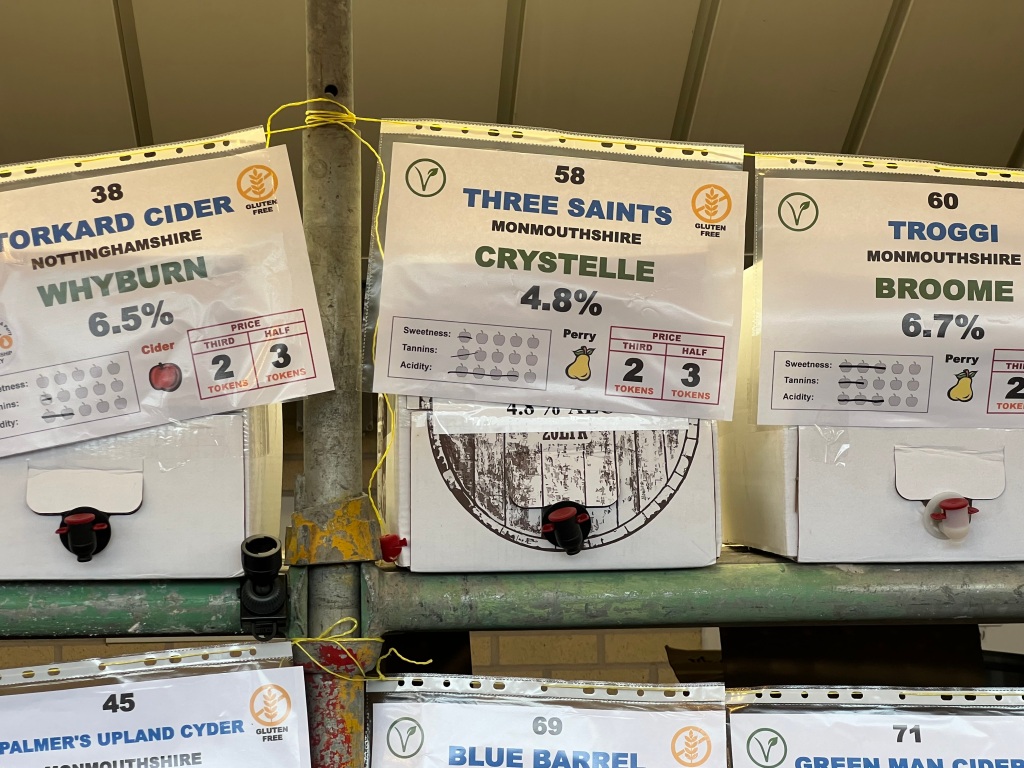
Helping to curate this bar every year is my friend Amy Chandler – without doubt one of the most passionate, funny, people-person advocates of cider and perry you’ll find. She had invited me up to Nottingham that year, and after the judging was completed, back down at the bar I discovered the Crystell perry from Three Saints Perry & Cider. A variety and producer unknown to me at that point in time, but one that struck a chord. Over the course of the year I must have mentioned this perry and perry-maker to Amy a number of times. When it came around to the festival in 2023, and we were all seated at a table ready to commence judging, it quickly became apparent that a lady sat directly next to me was supremely confident at picking out flavour profiles and talking about cider and apple varietals.
“It’s great to meet someone with such an appreciation of cider and perry,” or something along those lines is what I said.
“Oh I don’t just appreciate it, I make the stuff,” replied the lady. “My name’s Jessica, I run Three Saints Perry & Cider.”
I felt the biggest blush sweep across my face. Amy, you surreptitious matchmaker!
“I’ve wanted to meet you for a year now, since I tried your Crystell perry,” I blurted out.
“How funny!” Jessica replied.
After judging had wrapped up for that year, I managed to get progressively tipsier in front of Jessica at the bar, sampling various eclectic ciders and perries. At some point it was agreed that I must come and visit her at her farm in Wales and see the perry pear trees that towered over the hillside. The right opportunity arose this Spring when I spent a long weekend top-grafting in the company of Albert, Becky, Mike, John, et al at Ross Ciders’ orchards in Peterstow. Jessica is based just down the road, and into what felt like a Tolkein or Lewis novel – up a steep hillside, along a narrow track with grass growing down the middle, and potholes that identified as ponds. Let me take you now then into this world as we shine a spotlight on this fascinating Welsh producer.
* * *
CR: We’re here on location in Monmouthshire, Wales, up a steep and narrow country lane, near the towns of Usk and Llantrisant, but equally, quite removed from any semblance of urbanism. This is the Welsh countryside in Spring, and I’m joined by Jessica Deathe (pronounced Deeth), of Three Saints Perry & Cider. A noticeable reversal in the nomenclature there with the syntax of the words Perry and Cider to other makers. How long have you been producing perry and cider for?
Jessica: I started in 2002. We have lots of old perry pear trees on our farm. At the time we’d been visiting the Big Apple in Hereford, and we’d be visiting various other cider festivals, and we thought we’d try to make some perry out of the fruit from our trees.
CR: Where does the name Three Saints come from?
Jessica: I live in the parish of Llantrisant, which means Land of the Three Saints.
CR: Ah so following the geographical location route for naming, I like it! Was there a gap between making it for your own personal use, and deciding to sell it and setting up the company?
Jessica: It all happened around the same time really.
CR: We’re here on your hillside farm. Is there a history of perry making here?
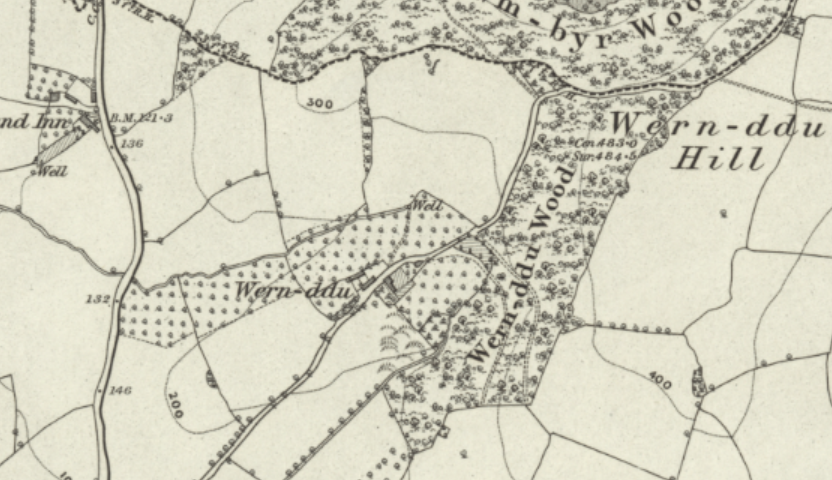
Jessica: Yes, very much so. The whole of Monmouthshire, and especially this area here where I live, was covered by orchards, the whole of the way up the valley. The town of Chepstow is only down the road, and all the fruit and veg produced up here used to go to Chepstow and be ferried up and beyond to London and the Midlands. So there really are a lot of very old fruit trees around, but perry especially in Monmouthshire was good. It just was something that happened here successfully, so there are a lot of local perry pear varieties in this area.
CR: Driving up to your farm I didn’t get the sense of acres of orchards as far as the eye can see. What’s left today?
Jessica: It’s just remnant orchards left now unfortunately. Here on my farm, further down in the valley proper, we’ll visit my old orchard. My new orchard I planted up here by the farmhouse, on a much higher elevation.
CR: Is there much difference with the growing style of the trees on the different elevations?
Jessica: I haven’t seen evidence of it. I was told that I would be foolish to plant trees this high up, but actually, they’ve grown perfectly well up here.
CR: We’re now in your cider shed, what do we have in here?
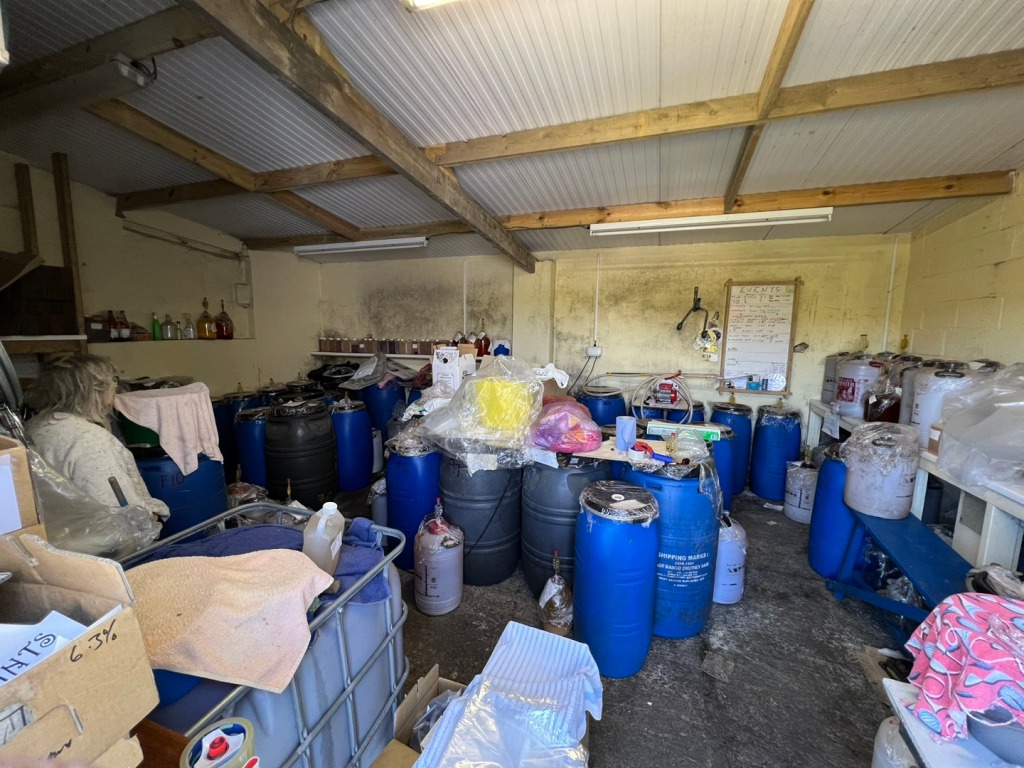
Jessica: Everything on the left-hand side of the shed is cider, and everything on the right-hand side is perry. All the containers (blue oak, aka plastic barrels) have something in them. I put cling film on the top of each barrel to keep things cleaner, and then there’s a little tag on each barrel which lists the year of production, what’s inside it, what the state of the drink is right now, a little bit of additional information. I do quite a lot of blends, but I also make single varieties of perries and ciders that I know will sell.
CR: I really enjoyed your single variety Crystell perry at Nottingham Beer & Cider Festival two years ago. I’d never seen the variety before, never heard of you as a producer before.
Jessica: I think I’ve got the only mature tree unfortunately, but it’s been grafted onto more rootstock now, so there’s a chance it survives.
CR: I’ve planted one in the orchard I look after in Norfolk this Winter, so there’s a bit of a spread of the variety now at least. I also put in one of your Fig perry pear trees too.
Jessica: The one I like the best is Top Tree, which we’ll see in a bit. I personally don’t think Crystell keeps too well after two or three years. It needs to be drunk relatively young. So with the perries here, I rack them off into another barrel, and then keep them till I bottle them or fill a bag-in-box.
CR: What’s the split of perry to cider in here?
Jessica: It’s probably around 50/50 now. I started with just perry, because those were the trees I have on the farm. But then I’ve ended up making a bit more cider as that’s the drink that more people know and recognise.
CR: What are some of the cider apple varieties you’re working with up here?
Jessica: My favourite ones are Yarlington Mill and Dabinett. I like Ellis Bitter very much too. After that, it’s whatever I can get my hands on really. For the blends I choose to sell, I enjoy variations on those three varieties.
CR: Are you blending those at the start of fermentation?
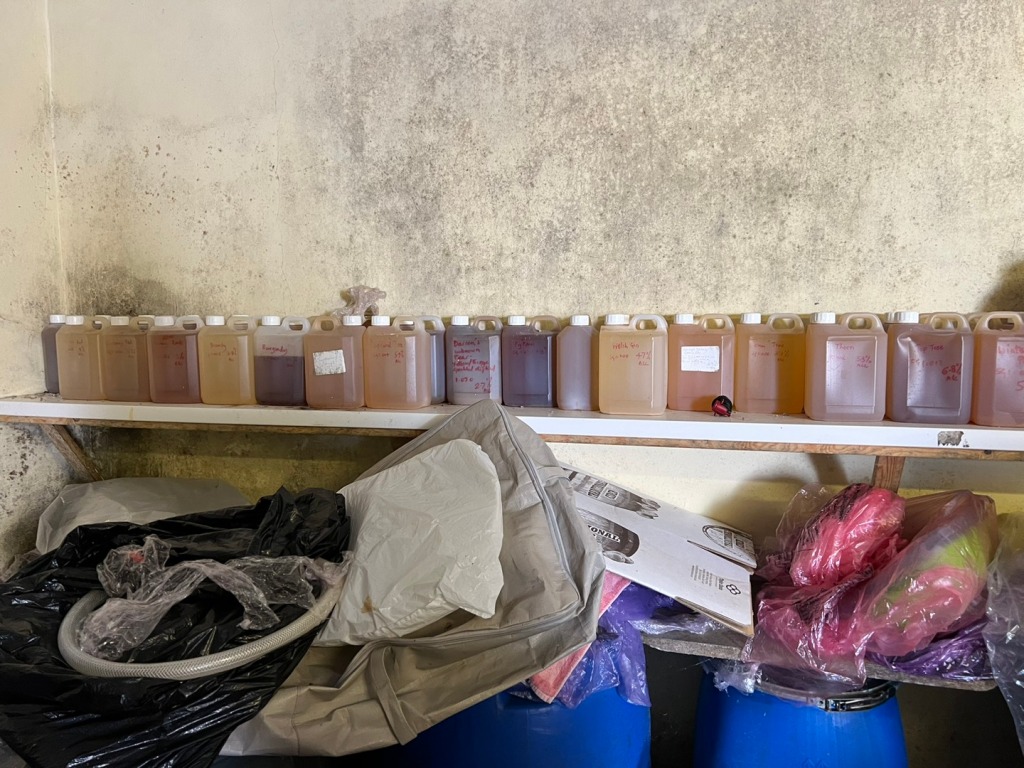
Jessica: Yes, I put those in barrel as a blend of the three juices from the start. On the shelf you see on the back wall is a library of all the single varieties of everything I’ve got access to. The one that’s wrong is Welsh Gin – I bought that variety, and so did the WCPS (Welsh Cider and Perry Society), we’re both told that it’s not actually Welsh Gin. It’s a fascinating perry though, when you press the juice it looks like whitewash, I’m not kidding, it looks milky. But it clarifies to a very pale hue over time.
CR: I think Barry, Sarah and I saw a couple of examples of Welsh Gin in the Hartpury National Perry Pear Collection last Autumn, I wonder if that’s the correct variety too?
Jessica: Some of the perry varieties have lots of colour in their finished drink, some not so much. They all have drastically different flavours too. I find it fascinating. Sometime soon I want to buy a real Welsh Gin tree. I’m also missing Oldfield, and Cwm, which a friend used to make a very splendid perry from and I don’t have in my orchard yet.
CR: Do you have many unique Welsh perry pear varieties here that we just don’t see even across the border into Herefordshire, let alone in the wider UK?
Jessica: Yes probably two of the best known are Burgundy and the Monmouth Potato pear. Burgundy is a likely sport or potential parent of Blakeney Red, very similar flavour profile, a really good, reliable perry. All sorts of juicy, jammy notes. Potato pear is peculiar, it’s the ugliest pear you ever saw. It looks brown and soggy and disgusting – takes a lot of pressing. It’s got an earthy, marmite, perry note. To me, it’s a fascinating flavour, but a lot of people don’t care for it, so I don’t make it very often as a single variety, I add it as a major contributing element of my blended perry. They grow to be a very big tree, quite spectacular to look at.
CR: The name stands out for sure. It’s quite unusual to have another fruit or vegetable name prefixing the pear name.
Jessica: I’ve also got the Lemon pear, which looks fairly lemony, and is a bit citrussy on the palette. As well as the Fig pear, which you know yourself, the fruit looks just like a fig, but with no real sweetness to the flavour. I’ve got it as part of a dual-tree, I’ve never made any single variety successfully from it. That’ll be up to you in a few years time!
CR: I’ll have to bring you a bottle in a few years time. I got my trees this year from the Welsh nursery, Tyn Y Berllan, I think they were a couple of years old. It’s such a nice coincidence that they reference you in the descriptions for some of their varietals. I did not expect to see some of these varieties for sale from a nursery in 2023 as it was.
Jessica: I’m very glad, because the more we reproduce these trees and grow them elsewhere, the safer they are for the future. I’ve lost one of the Gwern Ddu trees (pronounced Wuurndy), I had two, it’s from the original farm down the bottom of the lane where my main orchard is. It was divided into three: I had a third with the orchard in it, my neighbour has the remnants of the same orchard on the other side of the tree. He’s got a couple of Twisted Bark pear trees; a French variety whose name evades me; and a new one – it was unique, and he called it Edith. Our admin staff for WCPS did a lot of work a few years back trying to identify these varieties, DNA testing them. I got them to test some of my neighbour’s trees too at the same time.
CR: Is Twisted Bark any relation to Flakey Bark?
Jessica: They’re two separate varieties. You can really see why it’s called that when you look at the trunk in a bit, it spirals upwards.
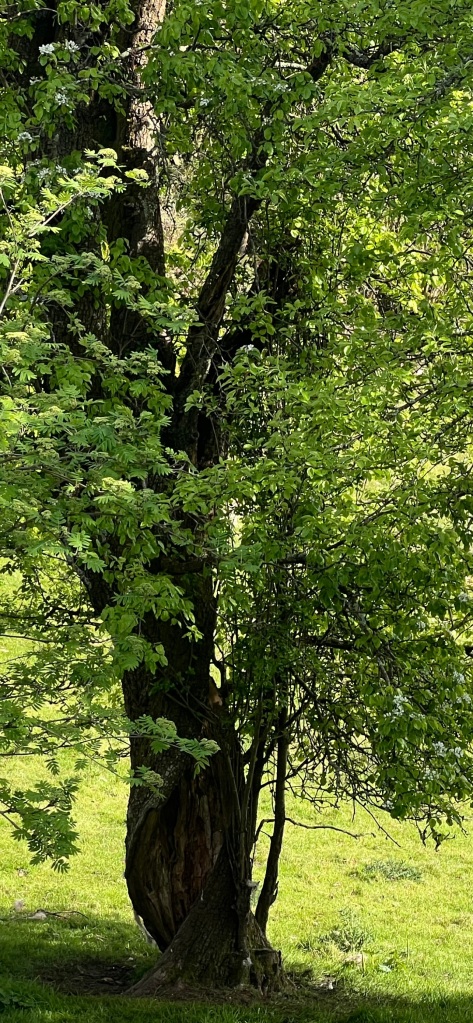
CR: You’ve been here on your farm since 1983, where do you think the Welsh Cider and Perry scene is now in 2024? Not necessarily the macro producers, more the curious and interesting smaller producers on the scene.
Jessica: That’s down to two people: Dave Matthews and Alan Golding. They really helped create the Welsh Cider and Perry Society. It was their enthusiasm that got an awful lot of us going. Quite a number of people who had a few trees here and there then started to make perry and cider, and loved the whole process. There was a huge lot of us initially, some of us have subsequently disappeared, all very social, but most of us were you could say “recruited” at that time. At the Clytha Arms pub in Monmouthshire, they had a cider festival every year, we used to take over their garage and all sell our produce from there. It was great fun.
CR: Do you find that same joy in production now in 2024?
Jessica: Oh yes, but none of the festivals have really come back in force since Covid in 2020. I find that very sad. All the events we used to visit seem to have dried up.
CR: It’s amazing in that sense that I’m from Norfolk, discovered your perry in Nottingham, with you producing here in Wales. Thank goodness for folk like Amy there championing the cause and giving routes to festivals for small-scale producers from all over the UK.
Jessica: Oh yes absolutely! I’ve recently started tasting the Berllanderi Red in here. I’ve had it as a blend before, but it’s rather a sumptuous perry on its own, so I think this year I’ll release it as a single variety perry. I also get folk asking me to come and pick their pears, and quite often their eating varieties, dessert pears. I do a blend called Nice Boys, which always contains a certain amount of dessert pears. The guys whose pear trees I picked from for that blend, well they’ve now gone over to France I think, and the new owners took the tree out as it was dropping fruit all over the drive. But I make that blended perry in tribute to them and the tree that is no more.
CR: Immortalised in a perry name! What’s the pressing facilities like here?
Jessica: Just behind you, a single screw press, and a nice big plastic scratter behind it. It works very nicely, I can make nice large cheeses to fit on here, I do most of the perry on here. I’ll pick and scratt the pears on one day, leave them overnight to macerate, and then do the pressing the next day.
CR: Am I right in saying you do everything here yourself?
Jessica: That’s right, I do everything myself. I do get a bit of help in harvest time from various people. I did start everything off originally with my husband, but he passed away, so it’s just me doing this now. But it’s a lot of fun. I do make cider and perry vinegar as well – not on this site, somewhere completely different, and that’s doing very well. I’ve created a completely sealed off-room in a friend’s barn. It sells very easily. When I visit country markets once a week with my BIBs and bottles, I have a stall and sell my cider, perry, and vinegar there. I’d like to return to the Steam, Vintage, and Ploughing events as I like attending them anyway, so it’s a pleasure to work there.
We walk from the cider shed, across Jessica’s driveway, to a big metal gate, behind which is located the Top Orchard – the newer of the two.
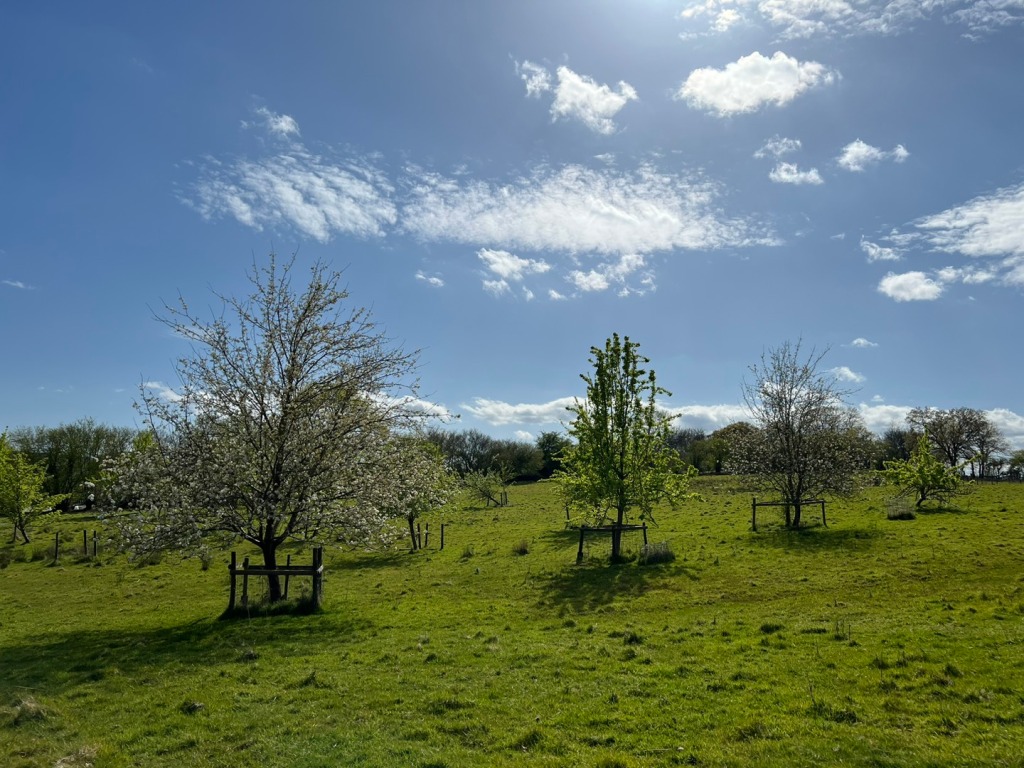
Jessica: I started planting this orchard after my husband passed away. So it would be 2006 I started planting the trees up here. The big trees you can see in blossom ahead are Potato pear.
CR: So we’re looking at 18 year old trees here in this orchard?
Jessica: That’s right, they were little whips when I bought them.
CR: Very similar aged trees to the Hartpury National Perry Pear Centre trees. I think they started going in around 2006 as well. What else do you have in this orchard?
Jessica: This orchard contains Brandy, Chapman’s Orange, Blakeney Red, Burgundy, Berllanderi Green and Berllanderi Red, Early Saint Brides, and at the very back, the slightly taller trees you can see are the Hellen’s Early.
CR: Is your intention to keep adding trees to this field to make it a fully stocked orchard?
Jessica: I have got more trees in my garden, but when they came to me I was a bit upset as they’d given me trees on bush rootstock, not on standard rootstock. Actually they’ve been in such good ground that they subsequently grown much taller than a typical pear tree on bush rootstock. I’m going to have to use a digger to get them out and put them in their right place. Because it’s a farm, they’re all supposed to have tree guards and protection around them. You can see where a few have collapsed and I’m beginning to replace them. The trees up the top are all cider apples. I’ve got Broome, Medaille d’Or, Tyn y Sherrif, a new one called Naomi, Ellis Bitter, Sweet Alford, Tom Putt, Cider Lady’s Finger, Michellin/Bisquet, Dabinett, Frederick,no Yarlington Mill…I put them in but they got waterlogged and they all died, so I need to replace them now.
CR: Is there a trade-off here between trees on bush rootstock that don’t grow as tall, so less wind damage due to the high elevation, and trees on standard rootstock that really anchor themselves into the landscape, reach all those nooks and crannies and minerals down below?
Jessica: If I’d planted the other way around in this field it would have been better. There’s a stony outcrop at the top of the field and pears would do better on that soil than the cider trees. I didn’t know that at the time. I got standard rootstock trees as this is a working farm, there are animals grazing around them, and you’d be surprised at how much the livestock will nibble at the trees.
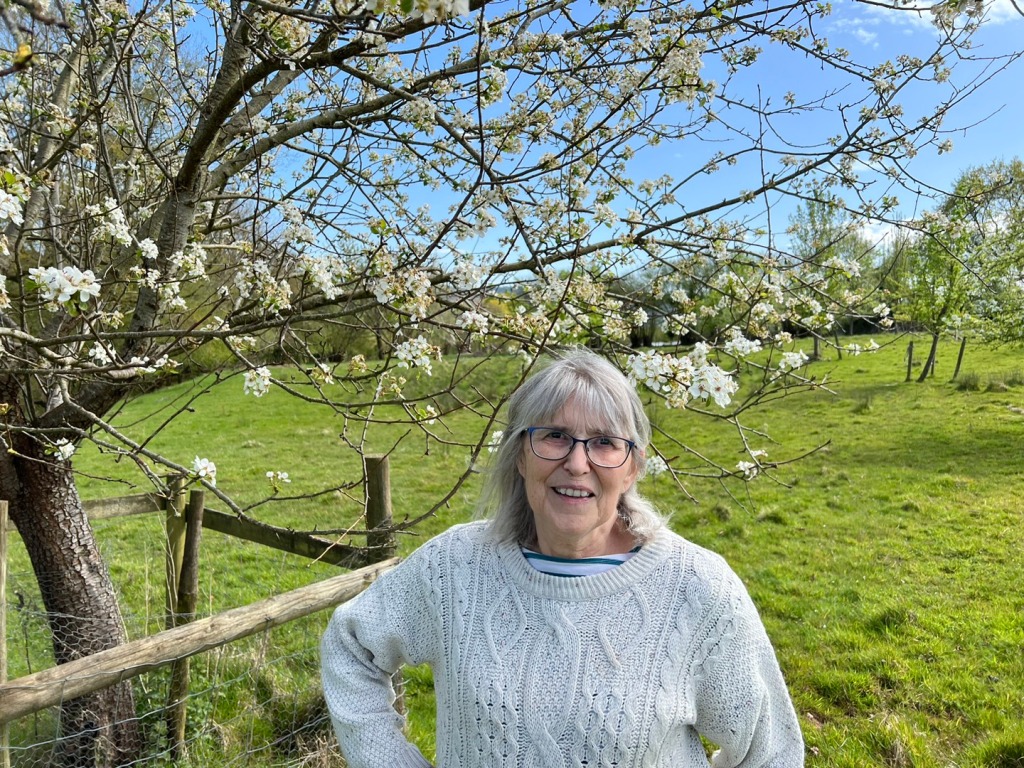
CR: It’s so lovely to see the pollinators out on this nice sunny day!
Jessica: There are a few hives up the road so the bees travel over here on a good day like today.
We then drive down the valley to Jessica’s other orchard, with the much older perry pear trees within. An orchard planted, I discover, in the shadow of a heavily dormant volcano!
Jessica: This orchard appears on a map from 1780, you can see the trees are marked on it then. I’ve interplanted with younger trees to fill in the gaps. Where I can, I’ve used stock from here. There are also some plums, damsons, cherries, and peach in here alongside the pear trees.
CR: We’re south-facing here, on a nice gentle slope with a great view out across Monmouthshire and beyond. You use the fruit from here for your perry?
Jessica: Absolutely! This is the Lemon pear tree. I named it that as when we DNA-tested it, it wasn’t a known variety. Because the fruit is lemony-yellow in colour, and has the passing appearance of a lemon, and definitely citrussy in flavour, it was named that. These two next to it are Burgundy trees, very upright growing habit compared to the Lemon pear tree. In my grandfather’s orchard just outside Bristol, I was never asked to prune the pear trees as they were so tall and upright, so it reminds me of them. He had 93 trees, and I was 10 or 11 and did all the pruning on them.
CR: Was he a perry-maker as well?
Jessica: Oh no! They were Methodists. Just for eating.
CR: It feels very humbling looking at a 300+ year old tree.
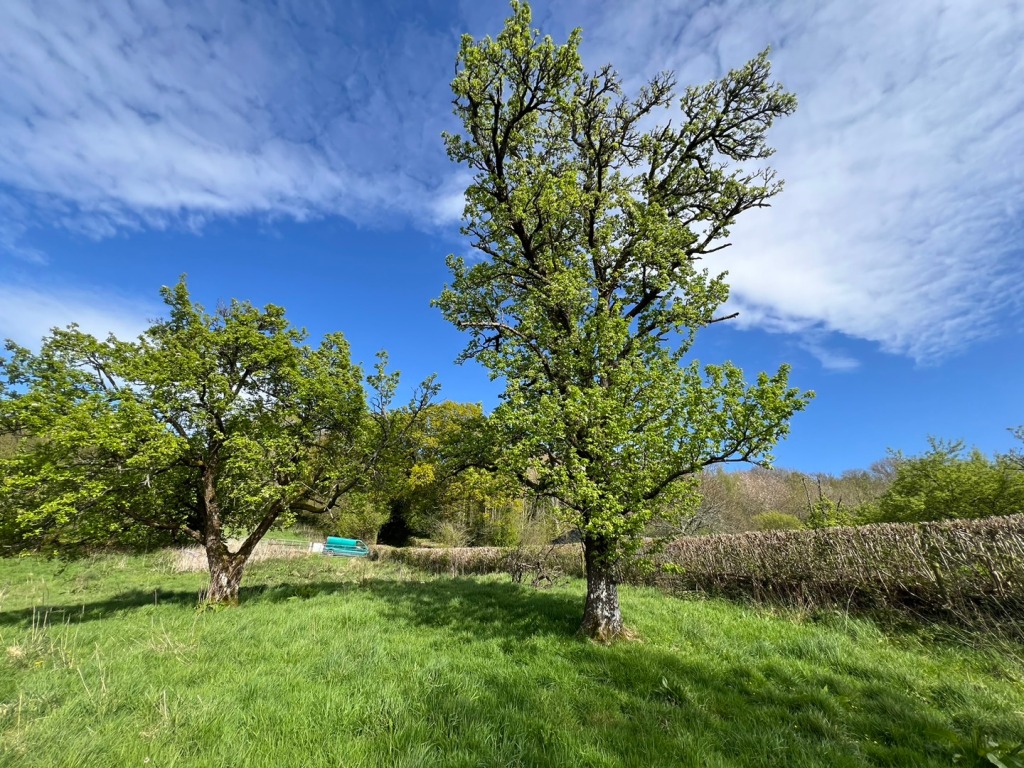
Jessica: Exactly. This is sadly the Gwern Ddu tree that came down this winter. It hadn’t been doing very well for a long time. I was going to give some of the wood from that to a chap who does wood turning. Ahead is one of the Potato pears, but not looking as lush as the ones in the top orchard.
CR: Where did you find the Burgundy trees to replant in here? I don’t think I’ve come across them in nurseries before.
Jessica: Back then you could get a grant for regeneration of old orchards. There was a chap called Davis who I bought them from and they were 2 year-old whips when they arrived. I also discovered some that were rootstock, interstem, and then the named variety on top. They became a much better, more substantial tree, a lot sooner than the trees just grafted straight onto rootstock. I’m not sure if you’ve tried the perry I made called Divine? It was from this tree just down at the bottom, which again, didn’t match any DNA records so I called the Divine perry pear tree. It’s another one that I call a young perry. Drink it sooner rather than later. I seldom use it any more, but it’s a very pleasant perry.
CR: It looks shape-wise like an old Oak tree and I can see the graft line quite low down.
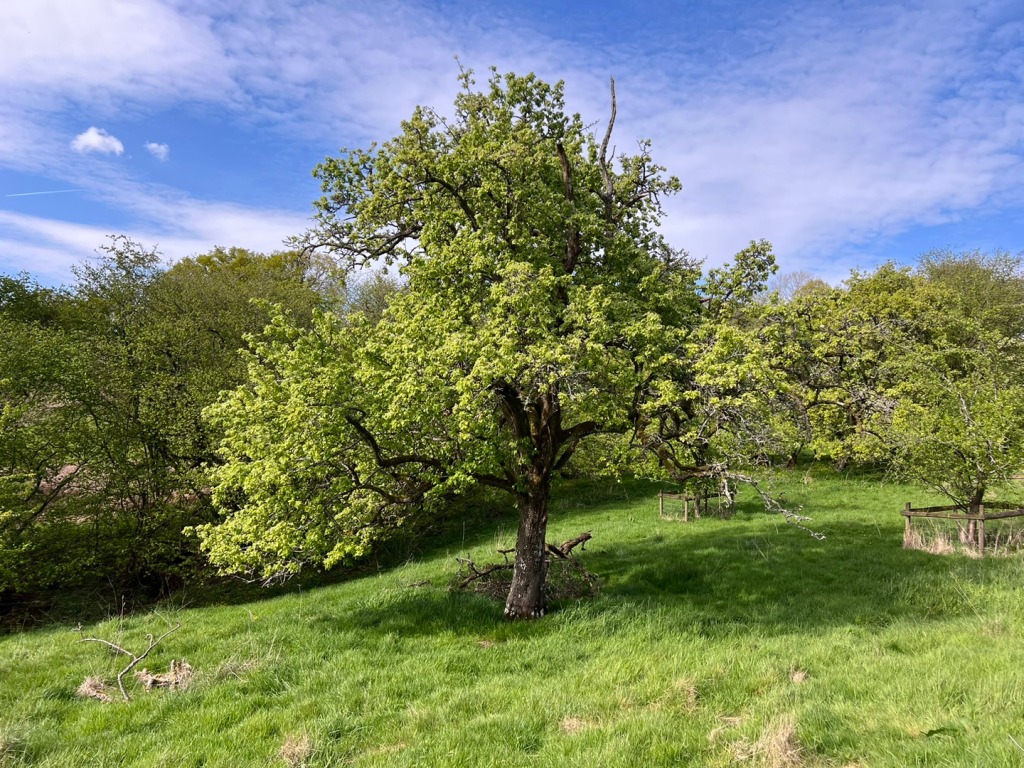
Jessica: Yes, most of these have a graft line that’s quite high up the stem.
CR: Suggesting they used to use the interstem method back then as well?
Jessica: Exactly. Right at the bottom are 4 trees called the Monmouth Winter pear. It ripens in November, quite a different variety. The DNA says that it’s Swan’s Egg, but it’s not. That variety from Ireland, typically fruit in October, but these fruit much later here.
CR: How many acres are we looking at for this orchard here?
Jessica: About 6 acres here.
CR: It’s quite frustrating to know that back in the day this whole valley would have been covered with fruit trees, and now it’s just these little remaining pockets.

Jessica: You’ll just have to imagine it now. Bordering the edge of the field are 5 trees. The one at the bottom is another Potato pear, then next up is another Gwern Ddu (but still surviving), then we have the dual tree with Fig and another variety on it, then Crystell above it, which is about half the size it used to be, a few branches have come down, and then above them all, is Top Tree, which I think is the most superb tree.
CR: It looks like an Elm tree, or an illustration of one as you don’t see many of those around in the countryside any more.

Jessica: Yes, very similar, very heavy. The fruit is tiny, so you really have to work hard to pick them all. The view of the tree is best from my neighbour’s kitchen. When the blossom is out, it’s absolutely stunning.
CR: You wonder what hands grafted this tree back in the day. They probably weren’t envisaging the tree would be around in 2024. The bark looks almost like that of the Coastal Redwoods they mentioned on the news a few weeks back. I must say this is a somewhat magical visit!
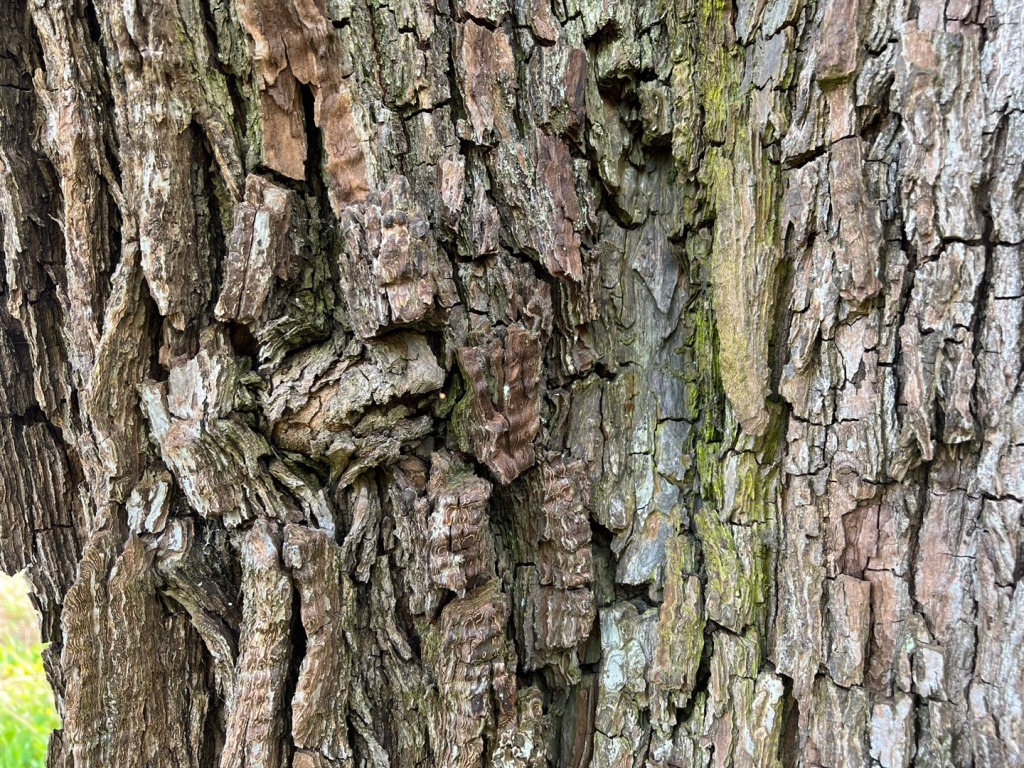
Jessica: You’re certainly lucky with the weather.
CR: Not wanting to jinx anything, you haven’t got any issues with fireblight around here?
Jessica: No. I used to pick further towards Monmouth, and they had a terrific problem with fireblight over there. They ended up replanting their orchards with Harry Masters Jersey and Chisel Jersey because of it. But no issue in this area thankfully. My problem here is: I can pick and make perry, I just don’t seem to be able to sell it as easily.
CR: It’s kind of outrageous for such a rarified, delicious drink, that it hasn’t got a wider following.
Jessica: Unfortunately not, I agree. It seems to be stout at the moment which is having a resurgence. It seems like it needs a TV Chef to rhapsodise about it, similar to how oxtail has become very fashionable again from the butchers.
CR: Our co-founder Adam has a new book out, called Perry: A Drinkers Guide. Hopefully that will help galvanise the perry drinkers and raise awareness. We just need to get Adam on a program with Gordon Ramsay then, and perry can become the new oxtail!
Jessica: Exactly!
CR: Well thank you so much for the tour of your cider shed and orchards, it’s been a real pleasure Jessica.
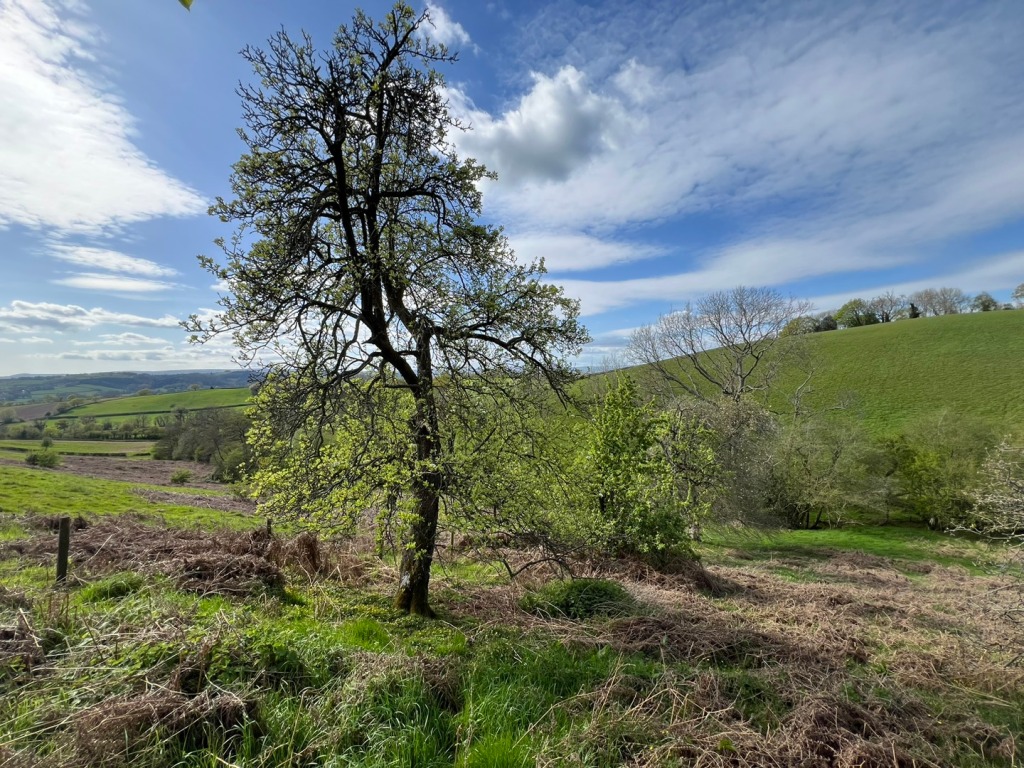
* * *
It was a total honour to be given this tour of Jessica’s orchards and operational facilities at Three Saints Perry & Cider. I hope that by shining a spotlight on her hillside production, a few more festivals and bars reach out to buy her drinks in bottle and BIB. Please do reach out to me if you’d like to introduce your customers to Three Saints – it absolutely deserves to be seen by a wider cohort of drinkers across the UK and beyond. There will be a follow-up review of a selection of these drinks in the coming weeks, alongside a spotlight on Tyn Y Berllan – the fruit tree nursery that has so importantly cultivated some of Jessica’s extremely rare trees for the wider public. They sit aside inspirational people like Cider Review’s Barry (of Kertelreiter fame too) and Albert at Ross Cider, for planting and grafting super rare, historical varieties of cider and perry trees so that we, the drinkers, can enjoy them once more in years to come.
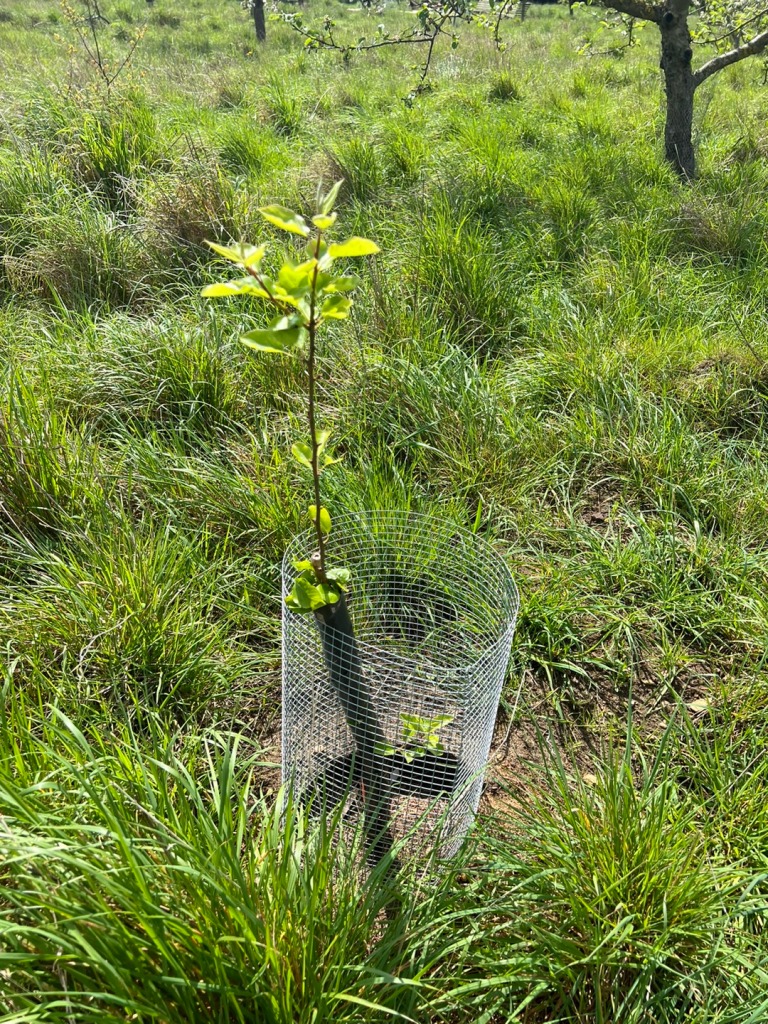
All photos by Jack Toye.
Discover more from Cider Review
Subscribe to get the latest posts sent to your email.
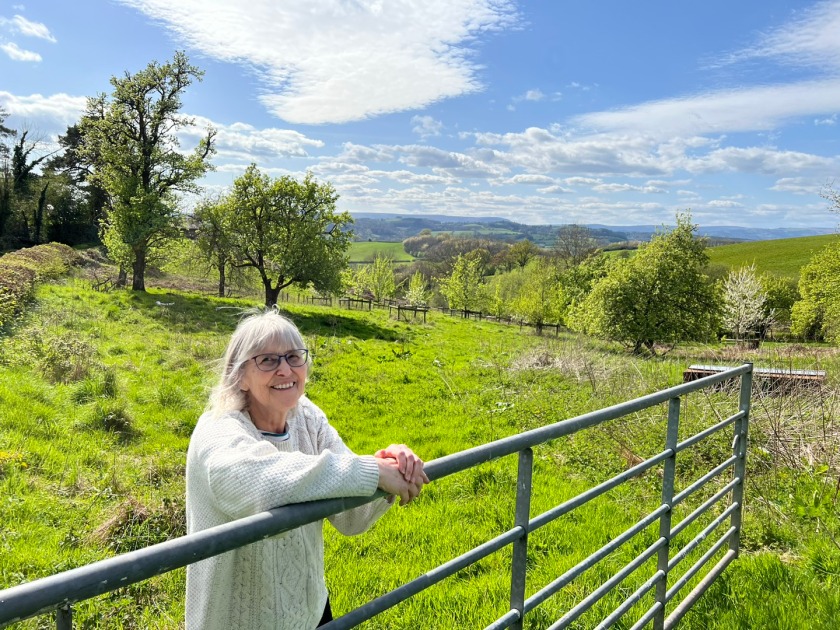
that’s a brilliant piece ! Loved reading it
LikeLike
Thank you Mike, glad you enjoyed it ☺️ Hope it helps raise the profile of Jessica and Three Saints, a magical place ☺️
LikeLike
they need a web shop!!!
LikeLike
they need a web shop!!!
LikeLike
Pingback: A Multi-Bottle Tasting of Three Saints Perry & Cider | Cider Review
Pingback: Introducing Tyn y Berllan – a very special fruit tree nursery in Pembrokeshire | Cider Review
An update on varieties in this article after consulting the DNA Database of Pears on FruitID and the Welsh Heritage Pomona:
Crystell: A unique variety
Lemon Tree: A unique variety
Fig Tree: A unique variety
The other half of Fig Tree: Louise Bonne of Jersey
Top Tree: Cefnydd Hyfryd, named in a few other places (a relief it’s not the last one standing)
Gwern Ddu: Boy pear, found across Monmouthshire and the Three Counties.
Twisted Bark: A French variety called Nouveau Poiteau.
Divine: Autumn Bergamot.
Fascinating to cross reference local synonyms with DNA results. Makes it all the more important to preserve Crystell, Fig, and Lemon as they were only seen here.
LikeLiked by 1 person
Pingback: Charnwood Cider: An Orchard in a Forest | Cider Review
Pingback: Harvest 2025 – The Producers Summary Pt 3 | Cider Review